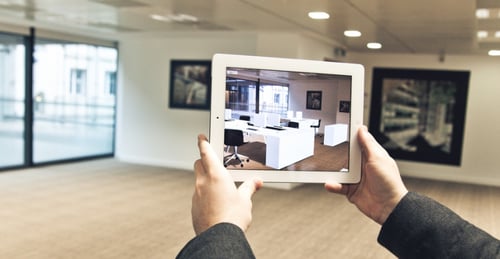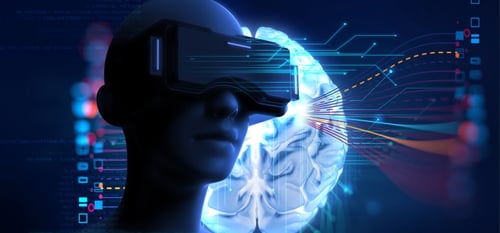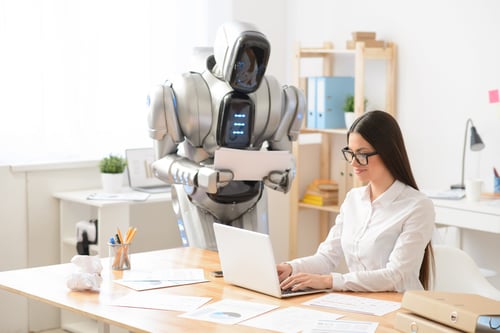|
Workplace Revolution: How Tech is Transforming the Workplace From virtual reality to AI, big data and much more – the world of work is changing rapidly. When you look back on the last ten years it’s amazing to see how much technology has changed the way we live and work. You don’t have to be that old to remember the days of fax machines and dial-up internet. Work was a slow sedentary process. Not anymore. Virtual reality, artificial intelligence, big data, machine learning, augmented reality and much more are all coming to the workplace and that raises all sorts of interesting questions. How can we get the best out of the technology to support the workforce? Can companies manage change effectively and – most importantly of all from an employee’s perspective – are the robots coming to take our jobs?
Virtual reality Experts are predicting big things for virtual reality. A report by Zion Market Research suggests it could be more than $26.89bn by 2020. While most of the focus has been on the gaming market, much of that growth will come from the enterprise sector. Work-based virtual reality is on the move and creating opportunities in all sorts of different sectors. Architects and designers, for example, can already immerse themselves into their designs and stand inside a structure before it has been built – no better way to sell a concept to a prospective customer than this. Car designers can do the same thing – sitting inside the car long before it even exists. It gives designers much more insight about how their work will look and feel when it is finished and helps them make better decisions. It helps eliminate problems at an early stage, reduces costs and means the final product will be better. And it helps the end-user emotionally connect with the space before its even been built. VR could also revolutionise mobile working. Skype and other video call software have already made it possible to communicate with people visually in different locations. Virtual reality could bring people even closer.
You could find yourself collaborating on a design in the same virtual space with people who could be spread across multiple locations around the world. It is bending time and space to bring multi-national teams closer together. Moving forward this can travel in many exciting directions. Augmented reality could be used to supplement the workspace. Crowded offices could be a thing of the past – just a set of AR glasses, a keyboard and a place to sit and everything you need can appear around you. In one corner you could have a list of your apps, in another a document you’re working on. You could pull up 3D images of designs and make any necessary changes. There’s no need to worry about space or clutter because you’re the only person who can see any of it. What will this do for the workplace? Wired have an article that says “The idea of an office full of people absorbed in AR might seem isolating, but collaboration could actually improve. Working together in mixed reality lets you share information in more useful ways than with email and Slack.” Ffull AR will mean we do away with the desk, the filing cupboards, the storagewalls, the pedestals and credenzas and instead workspaces will become futuristic spaces designed for comfort, work and play – as long as the worker has a functional chair that’s all that’s required - everything else is there in his/her virtual world. This shift is going to radically change the way we will see workspaces designed. 3D printing 3D printing has been bubbling under the surface for some time, but now it is becoming more widely available. A study from ReportsnReport expects the global 3D printing market to grow from $1.73bn in 2018 to $5.66bn by 2023. It has enormous potential for the world of work. 3D printers take a design from the computer and quickly turns it into a physical object. It greatly reduces the time and money required to create a model, which in turn helps companies bring products to market more quickly. Because the costs of making a 3D model are lower, you can make as many as you like. You can identify and fix problems more easily and experiment with various designs. All in all, it makes the creative process faster, less expensive and more efficient. |
Artificial intelligence One of the most talked about innovations is artificial intelligence. There’s a huge amount of interest in the subject, even though much of the technology is at an early stage. One of the key areas people are looking at is customer service. Chatbots are getting better at mimicking human speech and reacting to requests and demands. Banks are using it to relieve the logjam in their call centres. An AI powered chatbot will be able to answer most questions and only pass customers on if there is something more complicated that it cannot handle.
Virtual office assistants can relieve the strain of multiple emails. They act as your personal assistant and will even often have their own names. They can reply to emails, filter out those which are unimportant and free you up to concentrate on the ones which really matter. Much of the value of AI stems from the tide of big data flooding into the sector. In order to work well, AI needs a huge amount of data and it’s only in the last few years that we’ve been gathering data in sufficient volumes to make it work. Approximately 90% of all data ever created has come into being in the last few years and the pace at which we are gathering information is accelerating. By 2025, the amount of data in existence is expected to increase 10-fold. All that data is also becoming too much for many data handlers. Using machine learning and automated algorithms, computers can sort through all the incoming data in a fraction of the time it would take human workers. Using machine learning, it can recognise complicated and unstructured forms of data and sort this into an accessible and usable form for staff members to access as and when they want. It can produce intelligent graphs and clear, actionable, statistics without the need to manually sift through vast amounts of information. Rise of the robots Herein, though, lies one of the main concerns about new technology: what does it mean for us? The question being asked by everyone is – are the robots coming to take our jobs and, if they are, is this a good thing or a bad thing? Many of the technologies we’ve described here will replace jobs which are currently done by people and that will certainly be a challenge, but there’s nothing new in this. Technology has been changing work forever, and while machines take some jobs away, they tend to create new ones. A report from accountancy firm PwC suggests AI will create as many jobs as it takes away. So, while data analysts and customer service representatives may be worried about their futures, the technology should open up opportunities elsewhere. The big question will be how companies implement technology. Is it coming to cut corners, save money and replace people? Or is it coming to enhance the workplace and help people to do their jobs more effectively? And what will the workplace look like with multiple bots, machines and mechanical implements possibly taking over? How will we shape spaces to allow a successful marriage of human and robot working together in the workplace to increase efficiency, productivity and business success?
These are all questions I am not sure we have the answers for just yet – but what we do know is that workspace solutions such as acoustics, furniture, lighting, flooring, ceiling and walls will evolve quickly (aided by increased availability of 3D printing) to support these revolutionary tech trends fast moving into our spaces. Dwight Bailey |



